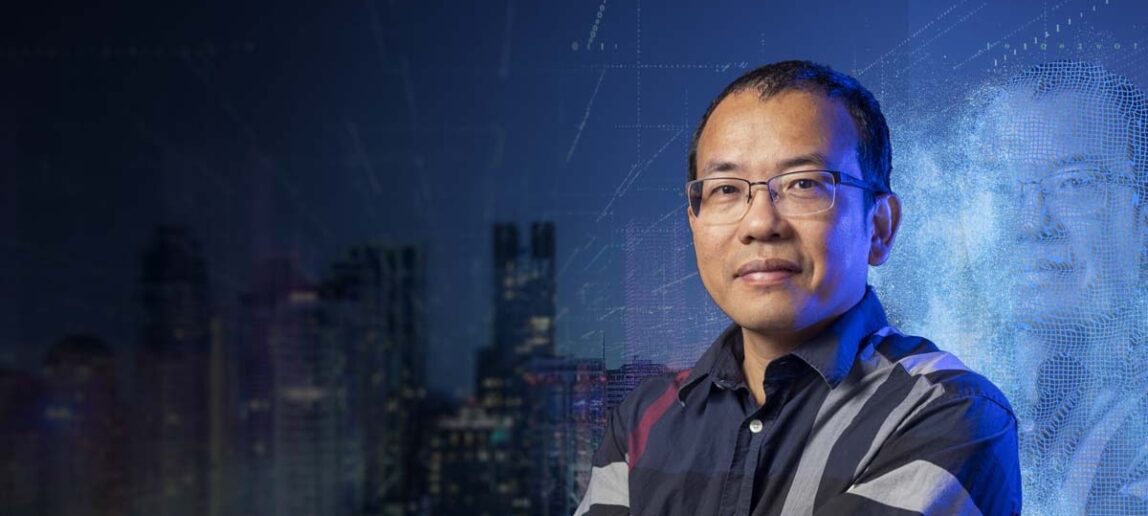One Place. Two Ways to See It.
Researcher establishing a new way for urban planners to see a community
Texas is growing.
Quickly.
The Lone Star State welcomed 850 new residents every day between June 2020 and June 2021, said the U.S. Census Bureau.
“We have lots of challenges and opportunities connected to this growth,” said Xinyue Ye, the Harold L. Adams Endowed Professor of Urban Planning and an American Association of Geographers Fellow.
Growth of this magnitude is accompanied by rising demands for housing, transportation, and parks — some of the crucial elements of a community that urban planners consider as they seek to create a vision for a community’s future.
The planning field, ever eager to harness the growth and ubiquity of technology, is at the early stages of a new way to understand and observe how cities work, and how people’s daily activities affect them, said Ye, who is also the associate director of the Texas A&M Center for Housing and Urban Development.
It’s a concept called “digital twinning.” At its heart, it’s a virtual model of a physical object, infused with continuously updated datasets. In the urban planning realm, a digital twin could be rendered as a 3-D model of a community that contains reams and reams of data — housing, transportation, socioeconomic, crime, zoning and a vast amount of additional data from a variety of public agencies, remote sensors and perhaps even data volunteered by citizens via their mobile phones.
Ye is one of the scholars at the forefront of establishing digital twins of cities and regions and exploring how the concept can be translated into widespread reality.
He is leading a team of scholars who are developing a digital twin of Galveston and portions of other Texas coastal communities in a National Science Foundation-funded study. The researchers are creating the twin to funnel the areas’ natural hazard resilience efforts from numerous federal, state, and local agencies into a cohesive strategy.
Digital twinning, said Ye, is the future of urban planning-related informatics — the analysis of reams of real-time data to anticipate planning outcomes and improve data-driven decisions of all types made by policymakers in cities and smaller communities. It’s an option that has previously not existed for planners.
Consider, for example, a digital twin of a busy intersection, something similar to where Texas Avenue and University Avenue meet in College Station.

A digital twin of this intersection would consist of comprehensive, real-time intersection data gathered from sensors and public agencies.
Data would be collected on the signal light cycle — the length of red lights, green lights, left turn lights, as well as the number of cars at the intersection, the length of time cars sit at the intersection, how long pedestrians need to wait at the intersection, and the pedestrian crossing signals.
Then, imagine access to this kind of data all along Texas Avenue and University Avenue, and on streets throughout Bryan/College Station, continuously updated in real-time, all archived and downloadable.
With access to all this data, transportation planners in the two communities might be able to work together to help the region’s traffic move more smoothly.
Then add more data. Where are residential, business, and industrial areas located? Where is road construction taking place? Where are new developments being planned?
Planners can then, for example, create simulations that would demonstrate solutions to the area’s ever-worsening traffic problems.
How much would traffic be decreased if land use patterns that reduced people’s reliance on cars were adopted in Bryan and College Station? If new housing were built atop existing one-story shopping areas, instead of further and further south in College Station? If traffic light cycles were changed and coordinated?
“We could have a virtual, digital twin to test transportation efficiency,” said Ye. “In other words, if it functions in a model, then we have the evidence-based option to use it in the real world instantly.”
It also promises significantly improved disaster planning and response capabilities.
When a storm strikes, accurate information is vital to emergency responders.
“Effective disaster response means that in a very short time, society needs coordinators at various municipal departments and private citizen groups to respond to emergencies,” said Ye. “Many decisions that may have life-or-death consequences need to be made immediately.”
But in a natural disaster there’s really no time to gather experts to make decisions.
“In a digital twin scenario, we could have lots of real time, integrated data flow on first responder resources, flooding levels, passable roads, and power availability, among many other things,” said Ye.
In some cases, digital twinning is already at a point where a system can quickly suggest actions based on existing data/new data, actions taken or not taken in the past, and the consequences of those actions, said Ye.
Some policymakers and citizens might be concerned that machines will be making these critical decisions.
“I want to emphasize that digital twinning, and the suggestions the systems make, doesn’t just run automatically without humans’ intervention,” said Ye. “Trained and experienced emergency managers will still be in charge. We need human beings to make these kinds of decisions.”
It’s similar, said Ye, to a pilot’s relationship to the automated systems on a commercial airliner.
“An airplane utilizes a digital navigation system, but of course we still need a pilot to fly it,” said Ye. “We don’t trust our lives to an airplane without anyone to monitor it. The same goes for a digital twin system.”
In the initial stage of his two-year, $300K Galveston and coastal digital twinning study, Ye is working with collaborators at Texas A&M-Galveston to study the city’s buyout program for property below sea level, or property that carries another type of risk.
“We are creating 3-D simulations of scenarios to envision potential futures in different parts of the city,” said Ye. “We are investigating, for example, the difference between Galveston’s property values if the city builds or does not build certain infrastructure in different parts of the city.”
The research team, which includes scholars in construction science, geography, landscape architecture, marine and coastal environmental science, and urban planning, are also studying natural disasters’ impact on business and transportation on the island.
The team is creating various scenarios of storm length and intensity, and their effects on businesses. This could help businesses safely prepare for when to close before a storm and anticipate the economic impact of remaining closed for a period of time after the storm.
Ye and his fellow scholars hope to help make the concept of digital twinning a widespread mainstay in communities of all sizes.


